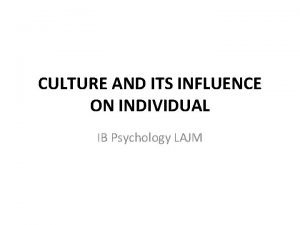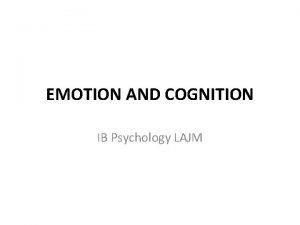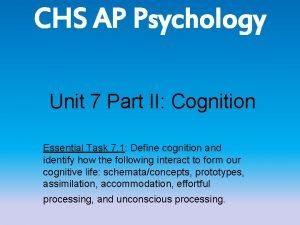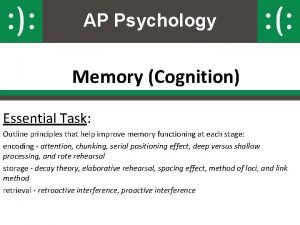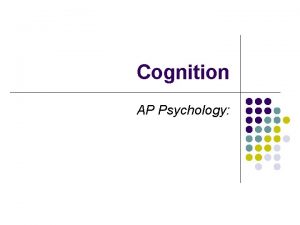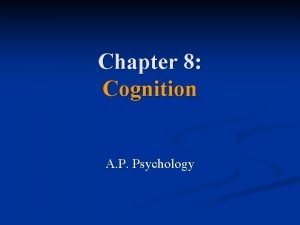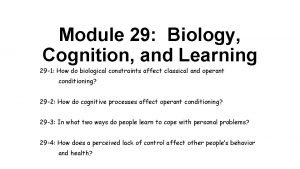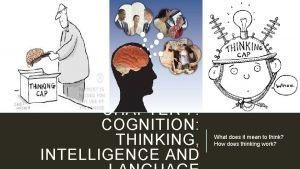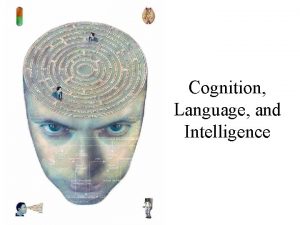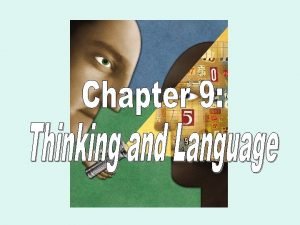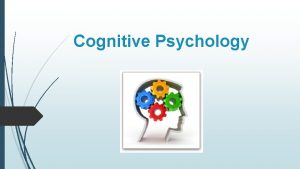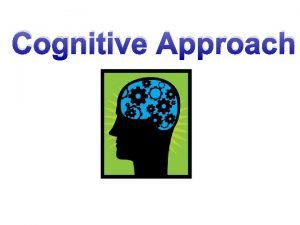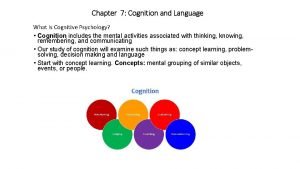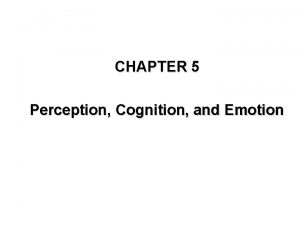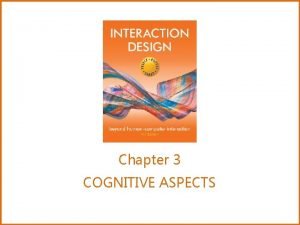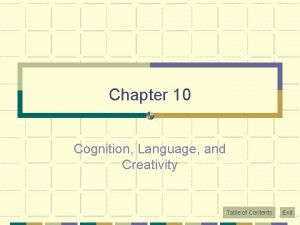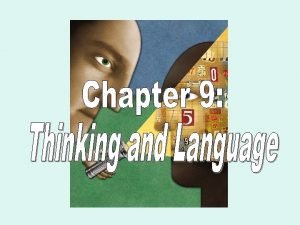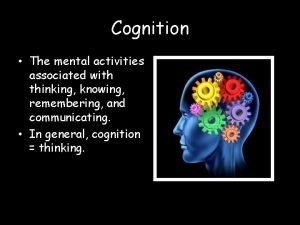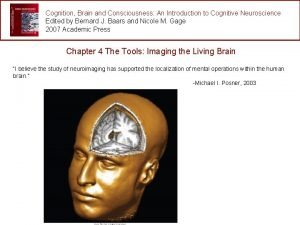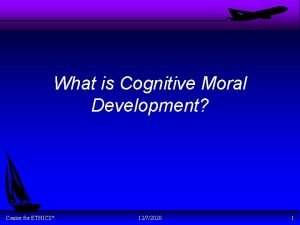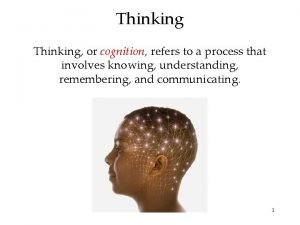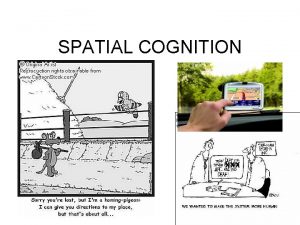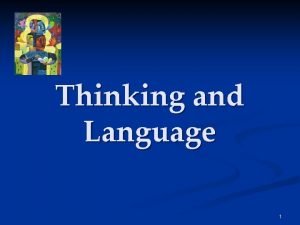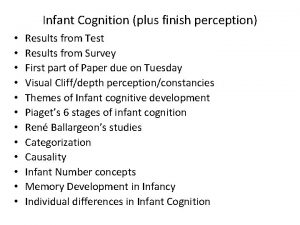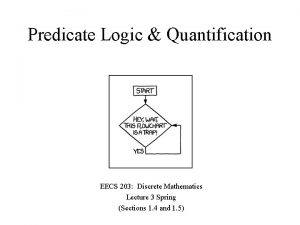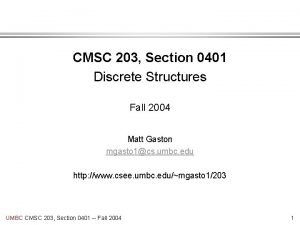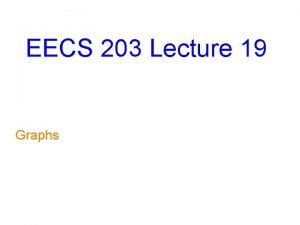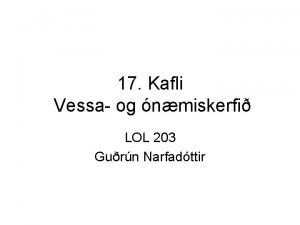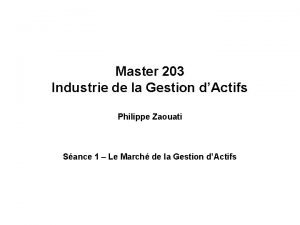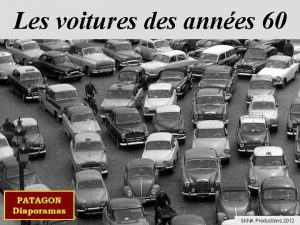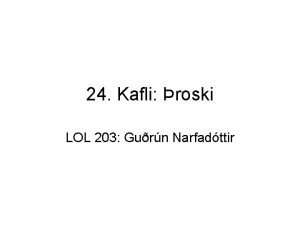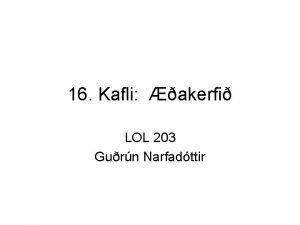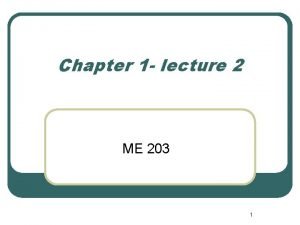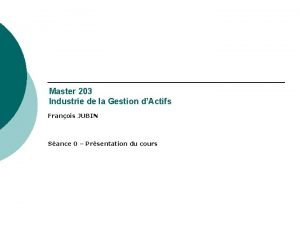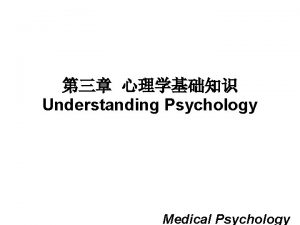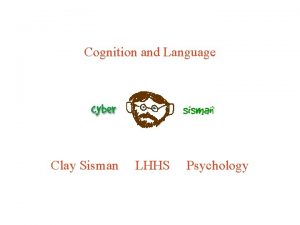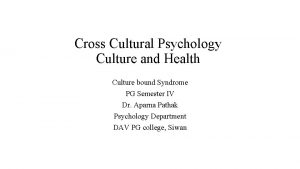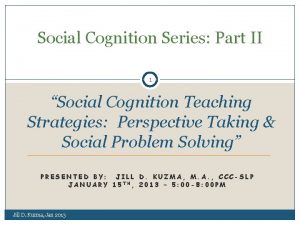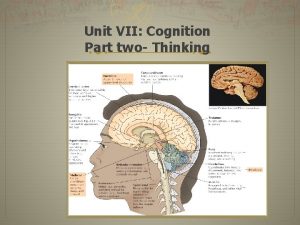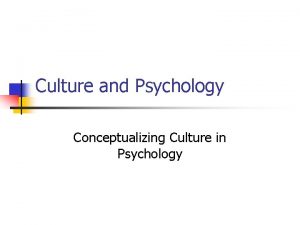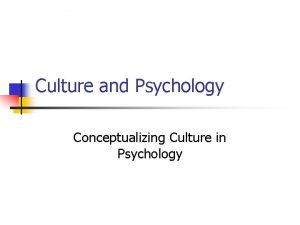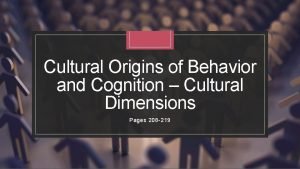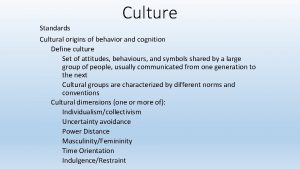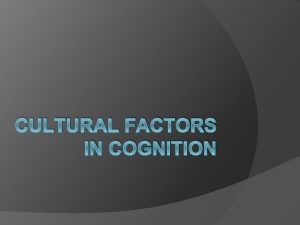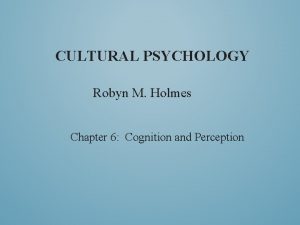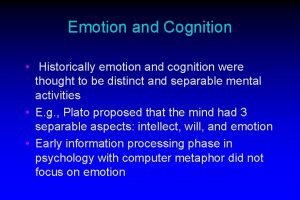Culture and Cognition Part II Psychology 203 Cultural



















































































- Slides: 83

Culture and Cognition: Part II Psychology 203 Cultural Psychology Winter, 2005

Logic East and West • “…the most striking difference between the traditions at the two ends of the civilized word is in the destiny of logic. For the West, logic has been central and the thread of transmission has never snapped…” – Philosopher Angus Graham • “. . . it is precisely because the Chinese mind is so rational that it refuses to become rationalistic and … to separate form from content. – Philosopher Hsu-Shien Liu • "The aim of the Chinese classical education has always been the cultivation of the reasonable man as the model of culture. An educated man should, above all, be a reasonable being, who is always characterized by his common sense, his love of moderation and restraint, and his hatred of abstract theories and logical extremes. “ – Historian Lin Yutang • “To argue with logical consistency. . . may not only be resented but also be regarded as immature. ” – Anthropologist Nobihuro Nagashima

Cognitive Differences: Logic vs. Experience • Norenzayan, et al. : Typicality vs. logic All birds have ulnar arteries Do sparrows have ulnar arteries? Do penguins have ulnar arteries?

Convincingness Judgments as a Function 9 of Typicality Typical Atypical 8. 5 Convincingness 8 7. 5 7 6. 5 6 5. 5 5 European American Asian American Korean

Cognitive Differences: Logic vs. Experience • Norenzayan, et al. : Plausibility vs. logic All animals with fur hibernate Rabbits do not hibernate Rabbits are not animals with fur

Valid Arguments Percent “Valid” Responses 100 95 Believable 90 Unbelievable 85 80 75 70 65 60 55 European American Korean

The “Socratic Effect” East and West • Socratic effect: asking people their beliefs about the probability of logically related propositions results in their coming into alignment when retested • Norenzayan & Kim (2002) Korean and American Ss • The price of dining out will increase • If stricter health codes for restaurants will increase the cost of hiring new staff, the price of dining out will increase • Stricter health codes for restaurants will increase the cost of hiring new staff • Koreans showed less Socratic effect than Americans • Only found for negative conclusions

PRINCIPLES OF FORMAL LOGIC • 1. Identity: A = A • 2. Noncontradiction: A ≠ not A • • 3. Excluded middle: A or not A

Eastern Dialectism • 1. – – • 2. – Principle of change: Reality is a process of change What is currently true will shortly be false Principle of contradiction: Contradiction is the dynamic underlying change – Because change is constant, contradiction is constant • 3. Principle of relationships (or holism): – The whole is more than the sum of its parts – Parts are meaningful only in relation to the whole • The Tao


Proverb Types • Dialectical Proverbs: – "Beware of your friends not your enemies, “ – "Too humble is half proud” • Non-dialectical Proverbs: – "One against all is certain to fall“ – "For example is no proof"

American and Chinese Preferences for Dialectical and non. Dialectical Yiddish Proverbs

Conflicts to Resolve • Mother-daughter conflict: • Mary, Phoebe, and Julie all have daughters. Each mother has held a set of values which has guided her efforts to raise her daughter. Now the daughters have grown up, and each of them is rejecting many of her mother's values. How did it happen and what should they do? • School-fun conflict: • Kent, James, and Matt are college juniors. They are feeling very frustrated about their three years of routine tests, paper assignments, and grades. They complain that going through this process has taken its toll, undermining the fun of learning. How did it happen and what should they do?

Percent of Participants Preferring Dialectical Resolution

Why Was Aristotle Wrong about Gravity? • • Argument 1 Aristotle believed that the heavier a body is, the faster it falls to the ground. However, such an assumption might be false. Suppose that we have two bodies, a heavy one called H and a light one called L. Under Aristotle's assumption H will faster than L. Now suppose that H and L are joined together, with H on top of L. Now what happens? Well, L + H is heavier than H so by the initial assumption it should fall faster than H alone. But in the joined body L + H , L and H will each tend to fall just as fast as before they were joined, so L will act as a “brake” on H and L + H will fall slower than H alone. Hence it follows from the initial assumption that L + H will fall both faster and slower than H alone. Since this is absurd the initial assumption must be false. Argument 2 Aristotle believed that the heavier a body is, the faster it falls to the ground. However, such an assumption might be false because this assumption is based on a belief that the physical object is free from any influences of other contextual factors (“perfect condition”), which is impossible in reality. Suppose that we have two bodies, a heavy one called H and a light one called L. If we put two of them in two different conditions, such as H in windy weather (W) and L in quiet weather (Q), now what happens? Well, the weights of the body, H or L, would not make them fall fast or slow. Instead, the weather conditions, W or Q, would make a difference. Since these kinds of contextual influences always exist, we conclude that the initial assumption must be false.

Figure 4. Percent of American and Chinese Participants Preferring Dialectical Arguments

Contradictory Statements • Statement 1 A: • A social psychologist studied young adults and asserted that those who feel close to their families have more satisfying social relationships. • Statement 1 B: • A developmental psychologist studied adolescent children and asserted that those children who were less dependent on their parents and had weaker family ties were generally more mature. • Statement 2 A: • A sociologist who surveyed college students from 100 universities claimed that there is a high correlation among college female students between smoking and being skinny. • Statement 2 B: • A biologist who studied nicotine addiction asserted that heavy doses of nicotine often lead to becoming overweight.

American Participants Ratings of Plausibility in Both "A or B Conditions" and "A and B Condition"

Chinese Participants Ratings of Plausibility in Both "A or B Conditions" and "A and B Condition"

Agreement with Propositions • About personality trait opposites: – How polite are you, how rude are you? – How outgoing are you, how shy are you? • About statements opposite in implication: – The more one knows, the less one believes, or – The more one knows, the more one believes – A person’s character is his destiny or – A person’s character is not his destiny

If Asians are Illogical, Why are They Better in Math than Americans? • Asians not illogical, they’re just less likely to use logic if: – Experience contradicts conclusion – Conclusions are undesirable – A resolution to a seeming contradiction is sought • When none of these true, Asians as logical as Am. – Westerners can go overboard with logic • Asians work harder in math -- now

Is it Language that Does the Job? • Generic noun phrases more common in Indo-European languages • In Chinese, no difference between – “squirrels eat nuts” – “this squirrel is eating the nut” – Only context can tell • Indo-European languages can turn any property into noun – “white” “whiteness’ • Western middle class parents decontextualize: “doggie”

Language, cont. • Western languages “subject-prominent” – “It” is raining • Asian languages “topic-prominent” – In Japanese: “This place, skiing is good” • In Japanese (and formerly Chinese): “I” depends on relationship: – Colleague, spouse, old college friends, child • Western grammar “agentic”: “he dropped it” • Eastern grammar: “It fell from him” or “fell” • In English: “more tea? ” In Chinese: “Drink more? ”

Figure 1 Chinese Language English Language PRC Chinese PRC and TW HK & S in PRC Chinese in USA Chinese in US European Americans

Attention to Object vs. Field • Abel & Hsu (1949) – Rorschach whole card responses • Ji, Peng & Nisbett (2000) – Rod and Frame Test (field dependence) – Covariation detection • Masuda & Nisbett (2001) – Attention to salient object vs. background – “Binding” of object and field • Masuda & Nisbett (2005) – Change blindness

Rod and Frame – Side View

Rod and Frame – Subject’s View

RFT: Errors and Confidence European Americans Chinese 3 Errors 2. 5 2 1. 5 1 0. 5 0 Errors on RFT 8 Perceived Performance 3. 5 Confidence Judgments 7. 5 7 6. 5 6 5. 5 5 Non-control Mode Control Mode

Arbitrary figures

Covariation Judgments 70 Covariation Judgments American Chinese 60 50 40 30 20 Non-control Mode Control Mode

Confidence Judgments American Chinese Confidence Judgments 90 80 70 60 50 Non-control Mode Control Mode

Seeing the Object and the Field (Masuda & Nisbett, 2001) Phase 1: Recall Task Participants 41 American participants at the University of Michigan and 44 Japanese participants at Kyoto University, Japan.

Phase 2: Recognition Task Fish with Original Background Fish with Novel Background

Previously Seen Objects (Japan) 78 76 74 72 70 68 66 64 62 60 Original Background Novel Background

Previously Seen Objects (USA) 78 76 74 72 70 68 66 64 62 60 Original Background Novel Background

Change Detection • • Japanese and American Ss Shown pairs of animated vignettes Asked to report differences across pair Do Japanese see more contextual (background and relational) changes? • Do Americans see more focal object changes?

Construction still 1

Construction still 2

Changes in Scene Across Two Vignettes

American City

Japanese City

American Farm

Japanese Farm

Number of detected changes Changes Detected in Objects and Context 4 USA 3. 5 JPN 3 2. 5 2 1. 5 1 Focal Object Information Contextual Information

Changes Detected in U. S. and Japanese Scenes Number of detected changes US scenes JPN scenes 4. 5 4 3. 5 3 2. 5 2 1. 5 1 Focal Object Information Contextual Information

Affordances in Japan and U. S. : Miyamoto and Nisbett • Take pictures in US and Japanese cities – New York and Tokyo – Ann Arbor and Hikone – Two villages • Compare complexity of comparable scenes – e. g. in front of post office, school

Electronics District – Tokyo

New York 2

Ratings of Complexity • • Number of objects Ambiguity of boundaries Degree to which parts of scene are invisible Orderliness vs. chaos

Medium Size Japanese City

Schematic

Number of Physical Features Found by Program • Number of Objects Defined at Two Sizes

Quilts

Framed Line Task: Target Stimulus Relative Task Absolute Task

Results: Experiment 1

Eyetracking (Chua and Nisbett, 2005) Study Phase

Chinese have poorer memory for old objects in new backgrounds p =. 03)

Chinese made more saccades to each picture presentation than Americans (p <. 05).

Chinese made more saccades to the background than Americans (p =. 003). There was no difference in number of saccades to the object.

Americans look at the object sooner than Chinese (p =. 02).

Americans have longer fixations than Chinese (p =. 01). Compared to Chinese, Americans also have substantially longer fixations on objects than on backgrounds (p =. 02).

Esthetic Preferences: Object vs. Context Masuda, Gonzalez and Nisbett (2005) • Drawings: house, person, river, tree, horizon – Anticipations: more detail about background for Japanese; higher horizons for Japanese • Photographs: person in some setting – Anticipation: central figure larger for Americans

American, Male

East Asian (Hong Kong), male

Task 1. 2. 3. 4. Studio-Sitting Model Studio-Standing Model Atrium-Sitting Model Atrium-Standing Model American Data East Asian Data

Narrative Accounts of Events Chua and Nisbett (2005) • Personal stories (e. g. , my first day in school this term) • Stories they read (e. g. , bad day in the life of a single mother) • Videos they watch (no-audio vignettes from British comedies)

Anticipations • Americans would report more information about the central figure • Americans would report seeing more intentionality (attempt to control events) • Taiwanese would report more emotion • ? Language effects for the bilingual Taiwanese?

Americans made more references to main character

Americans produced more intention statements

Taiwanese made more statements with emotional content

Are the Differences Confined to Asia vs. Europe? • Kühnen, et al. (2000): Field dependence for Americans, Germans, Russians and Malaysians • Knight, Varnum & Nisbett (2005): – Eastern Europe vs. Western Europe – Northern Italy vs. Southern Italy – Middle class vs. working class


Does It Matter? • Medicine – Dissection, surgery – vs. holistic practice • Modularization • Law – (lawyer/engineer ratio) – Conflict resolution – Contracts: sugar & snow • Debate – Marketplace vs. – Consensus – S. Korea and N. Korea • Rhetoric: structure of argument • Science: In 90 s, 44 US Nobels, 1 Japanese • International relations – (spy plane incident) • Human rights – contract or organism? • Religion – Blend in East – Religious wars rare in East – Cycles vs. utopias • Intellectual history • Education, Learning and IQ tests

Intellectual History East and West • Western dichotomies – Nature vs. nurture – Mind vs. body – Emotion vs. reason • Necessary and sufficient conditions tradition in the West • Quantum mechanics and Nils Bohr – Object in two different places at once (!) • Evolution • Primatology

Intellectual History, cont. : The Continent vs. the Anglo-American Tradition • Big picture ideas vs. small theories and concerns • Anglo-Am philosophers: ordinary language analysis: Gettier examples • Continental phil: – – – Phenomenology Existentialism Structuralism Post-structuralism Post-modernism • Marxism • Sociology: Comte and Weber • Psychology: Freud, Piaget, Lewin, Heider, historicalcultural psych vs. • Skinner

Intellectual History, cont. : Linear Utopias of the West Plato’s Republic Puritanism, Quakerism, Shakers Mormonism American and French Revolutions Communism, fascism Steady, linear progress Once attained, state is permanent Reached through human effort Usually egalitarian Usually based on a few extreme assumptions about human nature

Education, Learning and IQ Testing • Kim (2002) “We talk, therefore we think? ” • Cattell Culture Fair IQ test (Park et al. , 2005) • Spatial tests of IQ • Liu and Nisbett (2005) State-dependent learning • Watanabe (1998): Japanese children in American schools

Cattell “Culture Fair” type item

Spatial relations item

Social Context Change Effects on Word Recall (Liu & Nisbett, 2005)

Manipulating Culture-Specific Cognition • Priming manipulations: Higgins and Bargh • Hong, Chiu, & Kung (1997): culture-primed Hong Kong Ss • Peng & Knowles (2003): priming Asian vs. American identities • Kühnen et al. (2001): I vs. we and field dep. for Am. ; Cha & Schwarz (2005) for Koreans • Kühnen & Oyserman (2002): I vs. we and memory for context in which objects were seen • Masuda & Nisbett (2005): “affordances” of environment • Miyamoto, Masuda & Nisbett (2005): priming with Asian vs. American scenes and memory for objects vs. contexts • Predict Leu, Liu, & Nisbett (2005)

Changes Detected in U. S. and Japanese Scenes Number of detected changes US scenes JPN scenes 4. 5 4 3. 5 3 2. 5 2 1. 5 1 Focal Object Information Contextual Information

Degree of Overlap of Distributions
 Effect of culture on cognition ib psychology
Effect of culture on cognition ib psychology Teacup ib psychology
Teacup ib psychology Embodied cognition ap psychology
Embodied cognition ap psychology Priming memory examples
Priming memory examples Unit 7 cognition ap psychology
Unit 7 cognition ap psychology Unlike b. f. skinner, noam chomsky believes that children
Unlike b. f. skinner, noam chomsky believes that children Belief bias ap psychology
Belief bias ap psychology Embodied cognition ap psychology
Embodied cognition ap psychology Chapter 7 cognition thinking intelligence and language
Chapter 7 cognition thinking intelligence and language Module 29 biology cognition and learning
Module 29 biology cognition and learning Cognition thinking intelligence and language
Cognition thinking intelligence and language Iq of blacks
Iq of blacks Cognition and personalization
Cognition and personalization Non material culture
Non material culture Fed-batch
Fed-batch Difference between american and indian culture
Difference between american and indian culture Stab culture and stroke culture
Stab culture and stroke culture Folk culture and popular culture venn diagram
Folk culture and popular culture venn diagram Popular culture examples
Popular culture examples Urease test
Urease test Folk culture and popular culture venn diagram
Folk culture and popular culture venn diagram Stroke culture method
Stroke culture method Lawn culture
Lawn culture Surface culture deep culture and esol
Surface culture deep culture and esol Cognition refers to
Cognition refers to Thought content examples
Thought content examples Mse in counseling
Mse in counseling What is cognition
What is cognition Cognition definition
Cognition definition What is cognition
What is cognition Cognition vs perception
Cognition vs perception Altered cognition in older adults is commonly attributed to
Altered cognition in older adults is commonly attributed to What is cognition
What is cognition Cognition definition
Cognition definition Jalan pintas mental
Jalan pintas mental Cognition refers to
Cognition refers to Cognition thinking
Cognition thinking Complex cognition
Complex cognition Moral cognition
Moral cognition Example of cognitive dissonance
Example of cognitive dissonance Hippocampus taxi drivers
Hippocampus taxi drivers Language
Language Cognition plus
Cognition plus Individual culture traits combine to form culture patterns.
Individual culture traits combine to form culture patterns. Batch culture vs continuous culture
Batch culture vs continuous culture Characteristics of collectivism
Characteristics of collectivism Sub culture group
Sub culture group In an inert organizational culture,
In an inert organizational culture, Characteristics of quality culture
Characteristics of quality culture Rad 203
Rad 203 Eecs 203
Eecs 203 Fha 203h disaster loan
Fha 203h disaster loan Rad etx-203ax
Rad etx-203ax Etx203
Etx203 Afi 10-203
Afi 10-203 Cmsc 421 umbc
Cmsc 421 umbc 258×203
258×203 Rad etx-203ax-dsl
Rad etx-203ax-dsl Eet 203
Eet 203 Eet 203
Eet 203 Eet 203
Eet 203 Eecs 203
Eecs 203 Lol 203
Lol 203 Master 203
Master 203 1948 peugeot 203
1948 peugeot 203 145 in en yakın yüzlüğü
145 in en yakın yüzlüğü 203 fourgonnette
203 fourgonnette Lol 203
Lol 203 Lol 203
Lol 203 Dorm room 203
Dorm room 203 Un=9n-4 jika un=176 tentukan n
Un=9n-4 jika un=176 tentukan n Rumus un
Rumus un Rad etx 220a
Rad etx 220a Cpsc 203
Cpsc 203 Me 203
Me 203 Auburn university billing
Auburn university billing 203-019-4
203-019-4 952 203-0000
952 203-0000 Resource management guide 203
Resource management guide 203 Finc 203
Finc 203 Eet 203
Eet 203 Induction math
Induction math Master 203
Master 203 Cst 203
Cst 203
